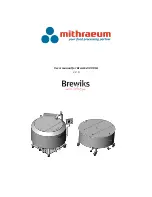
SMART 200 MP
22
5. ANOMALIES. PROBABLE CAUSES. POSSIBLE SOLUTIONS.
SYMPTOM. ANOMALY.
PROBABLE CAUSE.
POSSIBLE SOLUTION.
GENERAL PROBLEM.
GENERAL PROBLEM.
GENERAL PROBLEM.
GENERAL PROBLEM.
NOTHING WORKS.
NOTHING WORKS.
NOTHING WORKS.
NOTHING WORKS.
1. Make sure there is voltage at the entry to the machine, if
not the tapping must be changed. It is advisable to see if any
magnetothermal has "blown".
The machine has no voltage in one or all its
vital elements.
2. Check the power source fuses situated on the central
panel. (See Spare parts Sheet)
3. The machine panels must be removed testing the logical
points of the electrical diagram.
LIMITER TR
LIMITER TR
LIMITER TR
LIMITER TRIPS
IPS
IPS
IPS
Magnetothermal switch has low gauge for the
case. There may be a short circuit, which is
what causes the limiter to trip.
Change the magnetothermal for another larger gauge
one. It is important for the magnetothermal switch to have a
characteristic slow type curve. In the event that the electrical
installation has limited power the welding work must be
tested at lower current levels.
IT CAUSES NOISE
IT CAUSES NOISE
IT CAUSES NOISE
IT CAUSES NOISE
Loose metal casing.
Review and screw casing.
Defective electrical connections.
Correctly tighten the connections.
Damaged or poorly attached fan.
Examine the fan.
IF THE GREEN INDICATOR LD1
IF THE GREEN INDICATOR LD1
IF THE GREEN INDICATOR LD1
IF THE GREEN INDICATOR LD1
IS ON THE APPLIANCE DOES
IS ON THE APPLIANCE DOES
IS ON THE APPLIANCE DOES
IS ON THE APPLIANCE DOES
NOT WELD
NOT WELD
NOT WELD
NOT WELD
Active protection system. Amber light “LD2”
on.
Equipment overheated, wait until the equipment cools down.
Supply voltage outside rated margin. Change supply tap.
THE ELECTRODE BURNS IN TIG
THE ELECTRODE BURNS IN TIG
THE ELECTRODE BURNS IN TIG
THE ELECTRODE BURNS IN TIG
WELDING
WELDING
WELDING
WELDING
Excessive welding intensity for a certain
electrode.
Decrease welding current or change electrode for one with
larger diameter.
Use of reverse polarity.
Place electrode to negative pole.
Lack of protection gas.
Regulate at an appropriate flow.
THE EQUIPMENT HEATS UP
THE EQUIPMENT HEATS UP
THE EQUIPMENT HEATS UP
THE EQUIPMENT HEATS UP
ABNORMALLY.
ABNORMALLY.
ABNORMALLY.
ABNORMALLY.
THE THERMAL PROTECTION
THE THERMAL PROTECTION
THE THERMAL PROTECTION
THE THERMAL PROTECTION
ACTIVATES QUICKLY.
ACTIVATES QUICKLY.
ACTIVATES QUICKLY.
ACTIVATES QUICKLY.
The equipment is positioned so that it prevents
correct ventilation.
Place the equipment in an area where the air is constantly
replaced.
The fan does not work.
Replace the fan.
The equipment is located in a very hot
environment.
Avoid positioning where there is direct exposure to the sun.
There is a loose connection inside the
equipment.
Review the power electrical connections.
ALTHOUGH THE MACHINE IS
ALTHOUGH THE MACHINE IS
ALTHOUGH THE MACHINE IS
ALTHOUGH THE MACHINE IS
CONNECTED AND WITH THE
CONNECTED AND WITH THE
CONNECTED AND WITH THE
CONNECTED AND WITH THE
SWITCH LD1 ON, THERE IS NO
SWITCH LD1 ON, THERE IS NO
SWITCH LD1 ON, THERE IS NO
SWITCH LD1 ON, THERE IS NO
REACTION WHEN PRESSED
REACTION WHEN PRESSED
REACTION WHEN PRESSED
REACTION WHEN PRESSED
Failure of the pistol switch which does not
make perfect contact.
Change the gun microswitch.
WHEN THE GUN IS PRESSED,
WHEN THE GUN IS PRESSED,
WHEN THE GUN IS PRESSED,
WHEN THE GUN IS PRESSED,
ALTHO
ALTHO
ALTHO
ALTHOUGH WIRE COMES
UGH WIRE COMES
UGH WIRE COMES
UGH WIRE COMES
OUT, THE CONTACTOR DOES
OUT, THE CONTACTOR DOES
OUT, THE CONTACTOR DOES
OUT, THE CONTACTOR DOES
NOT WORK OR/AND THERE IS
NOT WORK OR/AND THERE IS
NOT WORK OR/AND THERE IS
NOT WORK OR/AND THERE IS
NO SHIELDING GAS
NO SHIELDING GAS
NO SHIELDING GAS
NO SHIELDING GAS
Electrical failure o solenoid vale faulty.
It must be established whether the fault comes from the
electronic board or if it is an electrical connection fault.
Check that solenoid valve coils are not open.
WHEN THE SHIELDING GAS IS
WHEN THE SHIELDING GAS IS
WHEN THE SHIELDING GAS IS
WHEN THE SHIELDING GAS IS
RELEASED IT CONTINUES
RELEASED IT CONTINUES
RELEASED IT CONTINUES
RELEASED IT CONTINUES
FLOWING.
FLOWING.
FLOWING.
FLOWING.
There is impurity in the inside chamber of the
solenoid valve which prevents the piston from
closing completely.
Dismantle and clean the electrovalve.
WHEN FINISHI
WHEN FINISHI
WHEN FINISHI
WHEN FINISHING WELDING
NG WELDING
NG WELDING
NG WELDING
THE WIRE REMAINS STUCK TO
THE WIRE REMAINS STUCK TO
THE WIRE REMAINS STUCK TO
THE WIRE REMAINS STUCK TO
THE TORCH CONTACT TUBE.
THE TORCH CONTACT TUBE.
THE TORCH CONTACT TUBE.
THE TORCH CONTACT TUBE.
Welding with the nozzle very close to the part
to be welded.
Correct the distance to the welding piece
WHEN FINISHING WELDING
WHEN FINISHING WELDING
WHEN FINISHING WELDING
WHEN FINISHING WELDING
THE FINAL WIRE LENGTH IS
THE FINAL WIRE LENGTH IS
THE FINAL WIRE LENGTH IS
THE FINAL WIRE LENGTH IS
VERY GREAT.
VERY GREAT.
VERY GREAT.
VERY GREAT.
The torch is withdrawn immediately when torch
pushbutton is no longer pressed.
The final wire length control system requires the welding
torch not to be immediately withdrawn when the torch
pushbutton is no longer pressed.
THE EQUIPMENT DOES NOT
THE EQUIPMENT DOES NOT
THE EQUIPMENT DOES NOT
THE EQUIPMENT DOES NOT
WELD CORRECT.
WELD CORRECT.
WELD CORRECT.
WELD CORRECT.
"IT ADJUSTS BADLY"
"IT ADJUSTS BADLY"
"IT ADJUSTS BADLY"
"IT ADJUSTS BADLY"
Low effective welding voltage. Output wave not
correct.
Check that there is not a phase failure in the supply power.
Check that the electrical contact elements of the welding
circuit are correct: Welding mass, rusty or very dirty surfaces,
contact nozzle with greater diameter than the wire, etc.
Test the electrical diagram of the power source. Input and
output voltages to the rectifier.
The welding wire has a mechanical resistance
at the outlet, which prevents it from having a
regular speed.
Examine the welding gun. Blow the inside (cable) with
compressed air.
THERE ARE MANY
THERE ARE MANY
THERE ARE MANY
THERE ARE MANY
PROJECTIONS IN THE
PROJECTIONS IN THE
PROJECTIONS IN THE
PROJECTIONS IN THE
WELDING PROCESS
WELDING PROCESS
WELDING PROCESS
WELDING PROCESS
Unsuitable shielding gas.
When welding normal steels we advise the use of a gas
mixture Ar-CO2.
















































